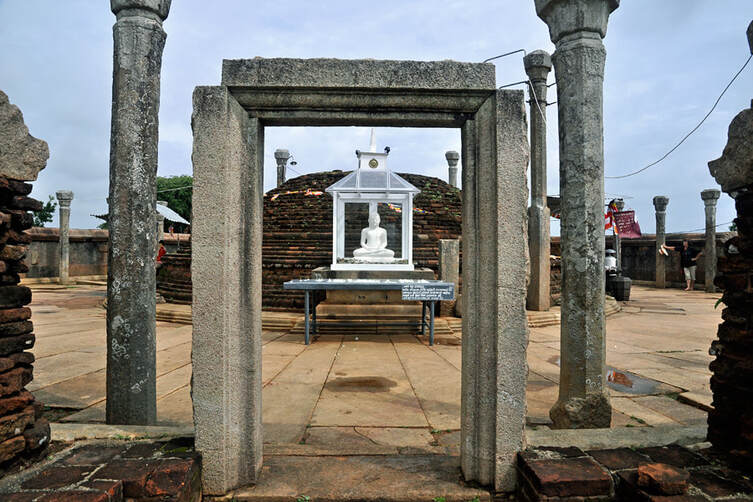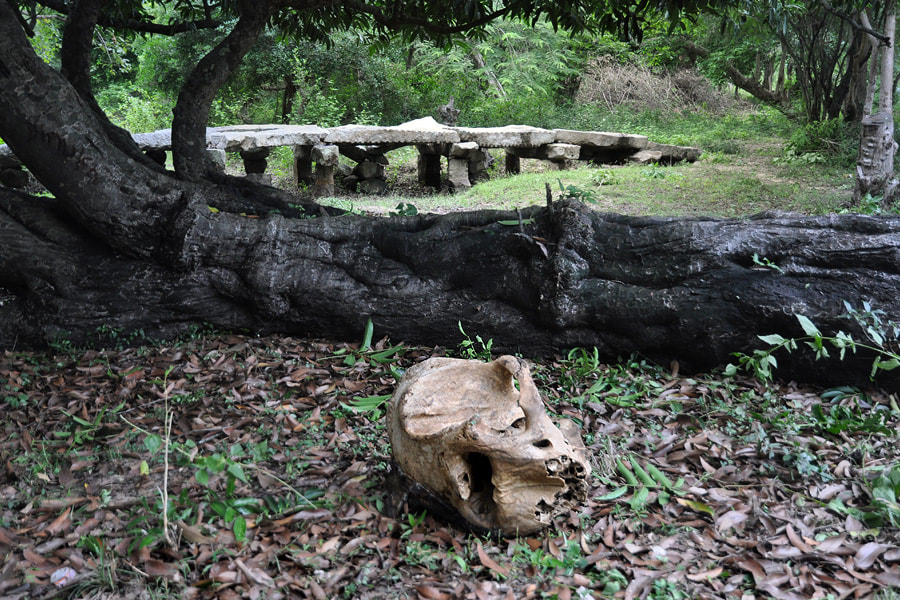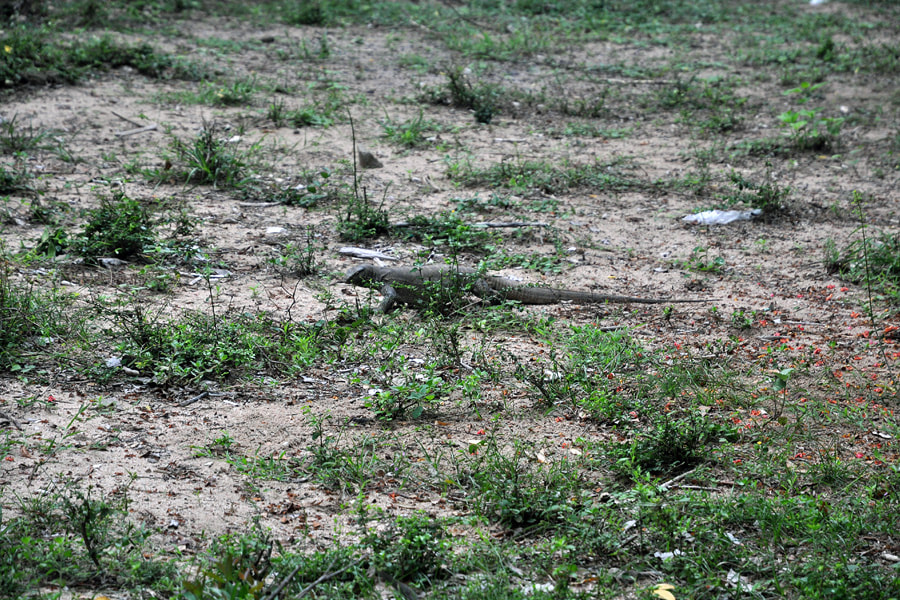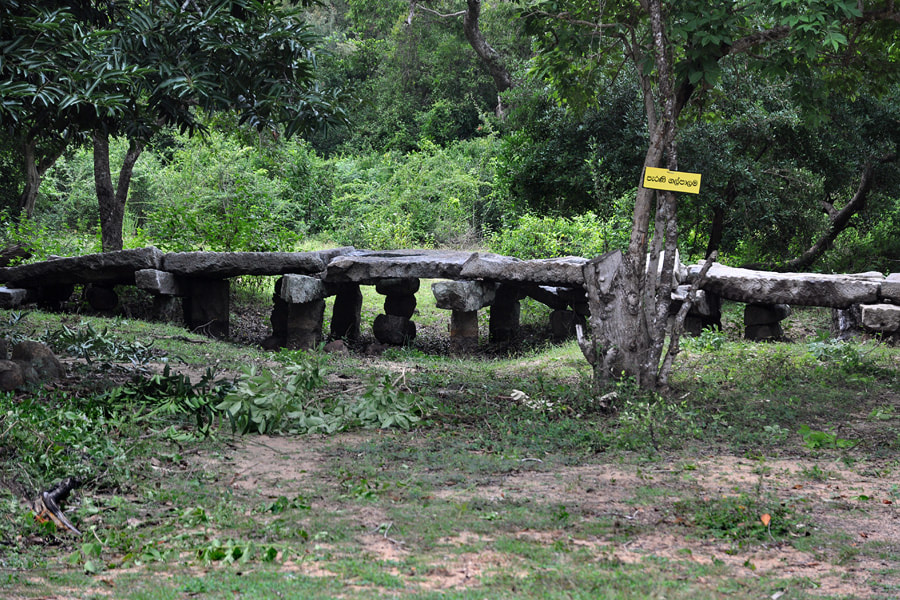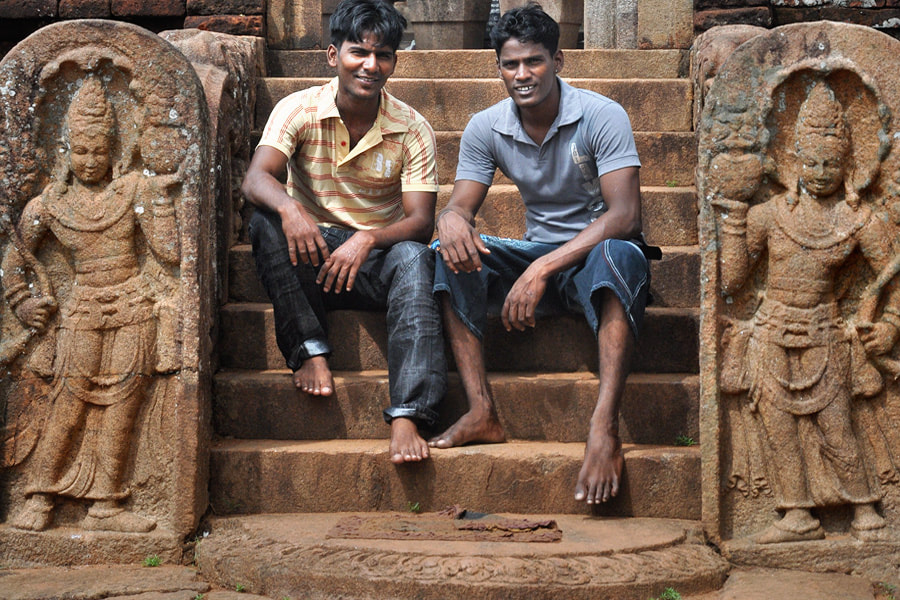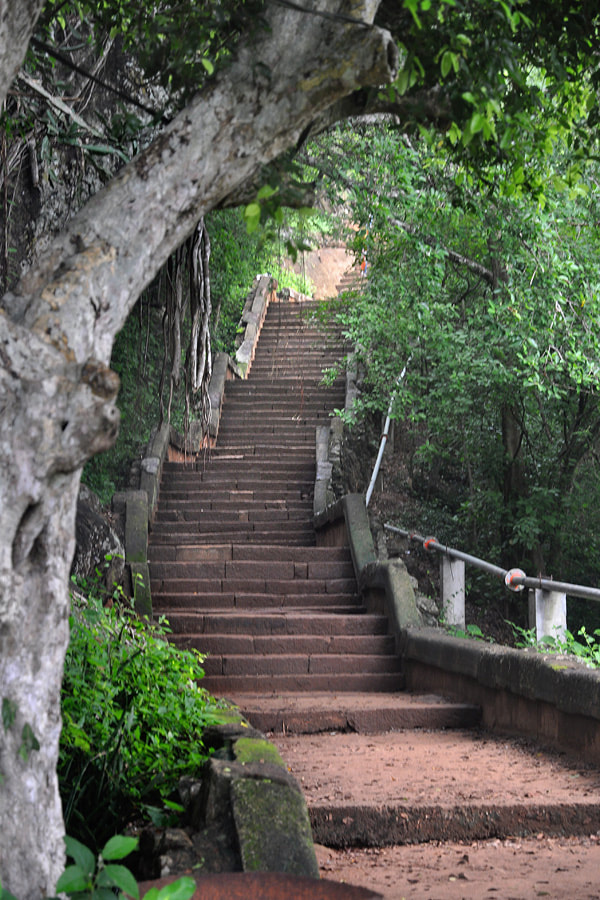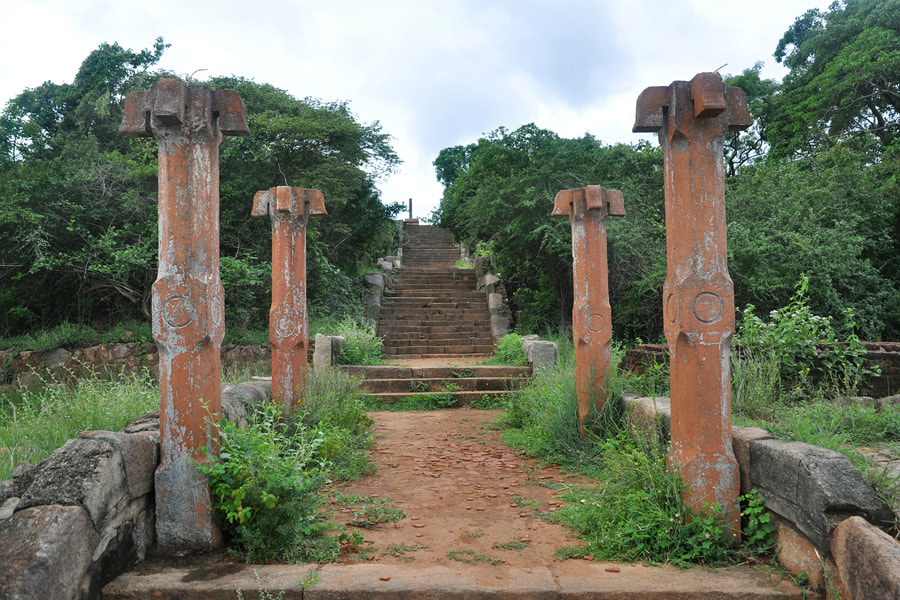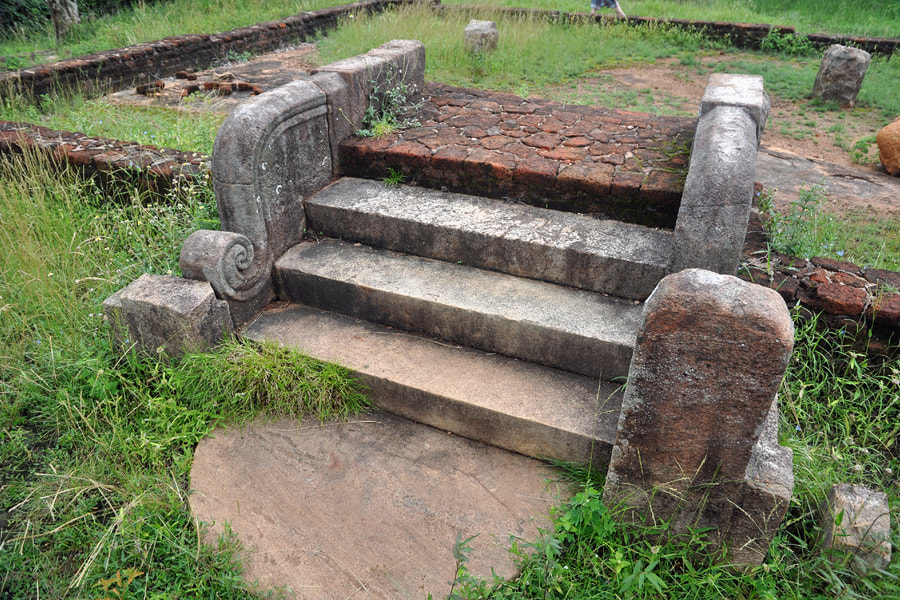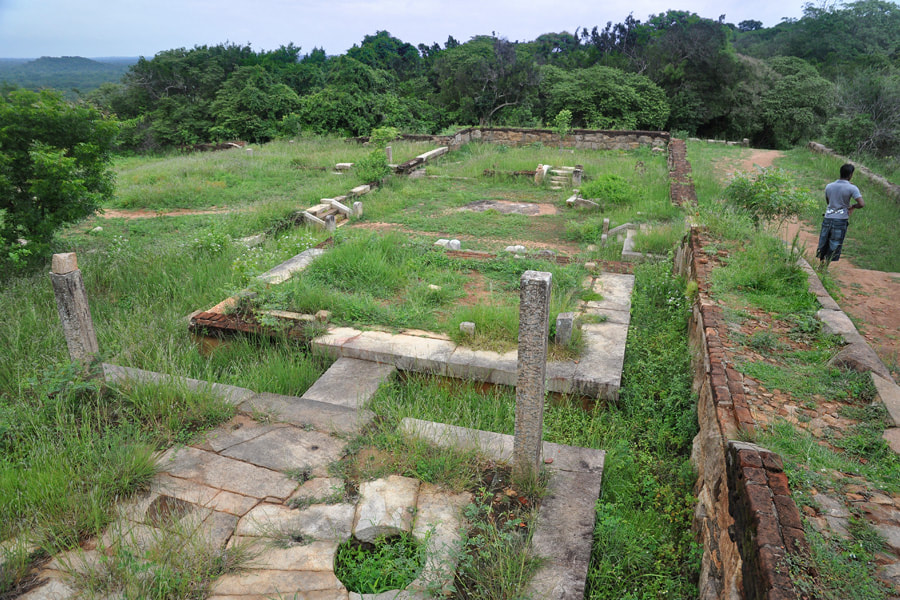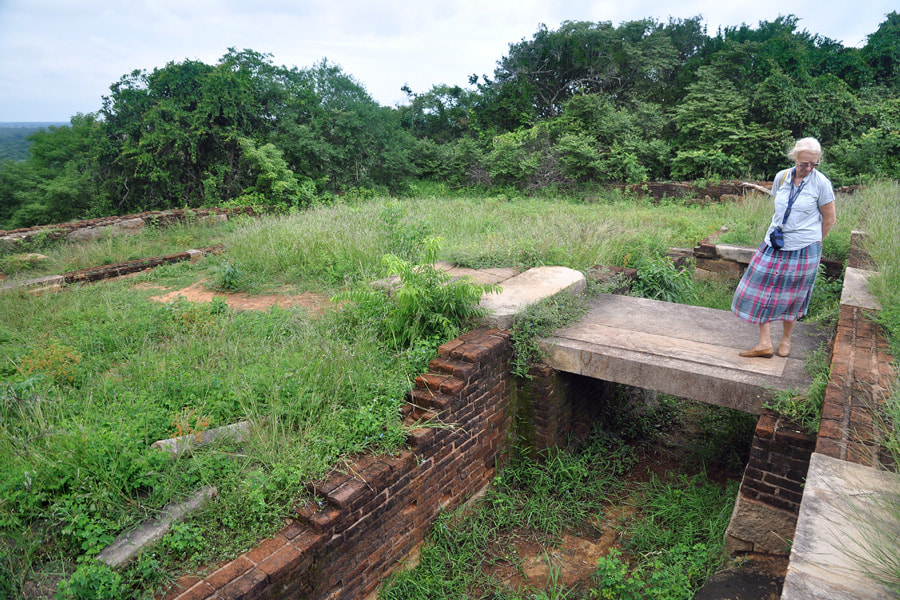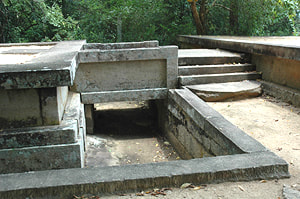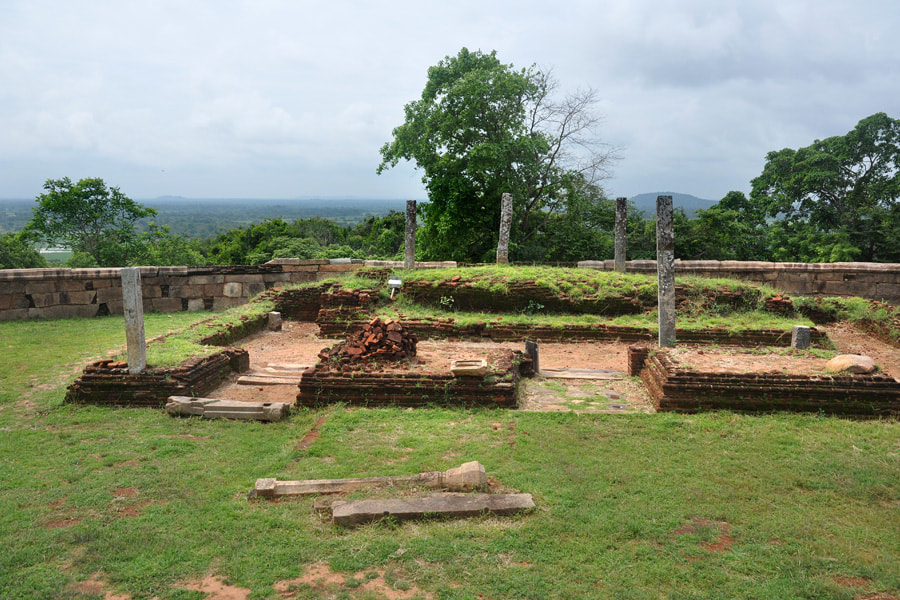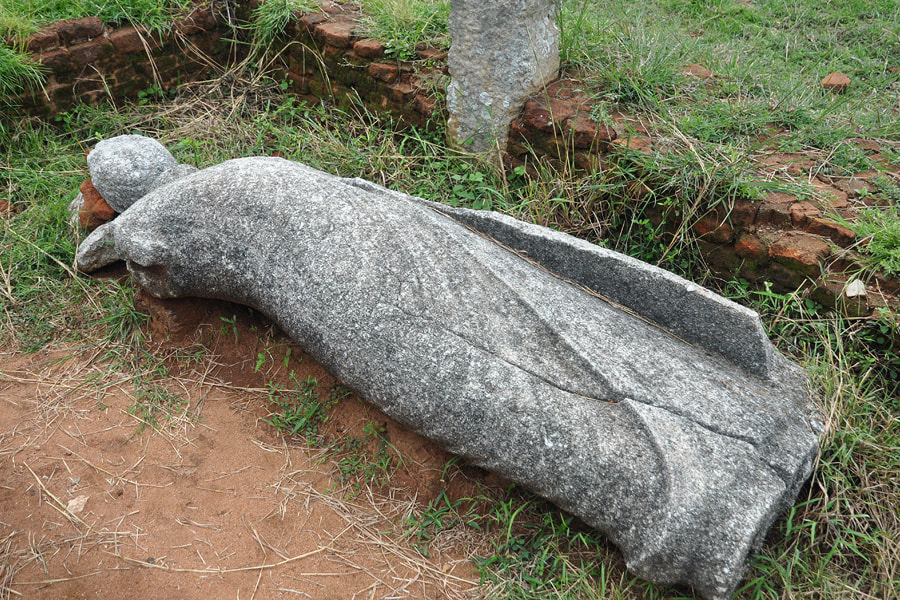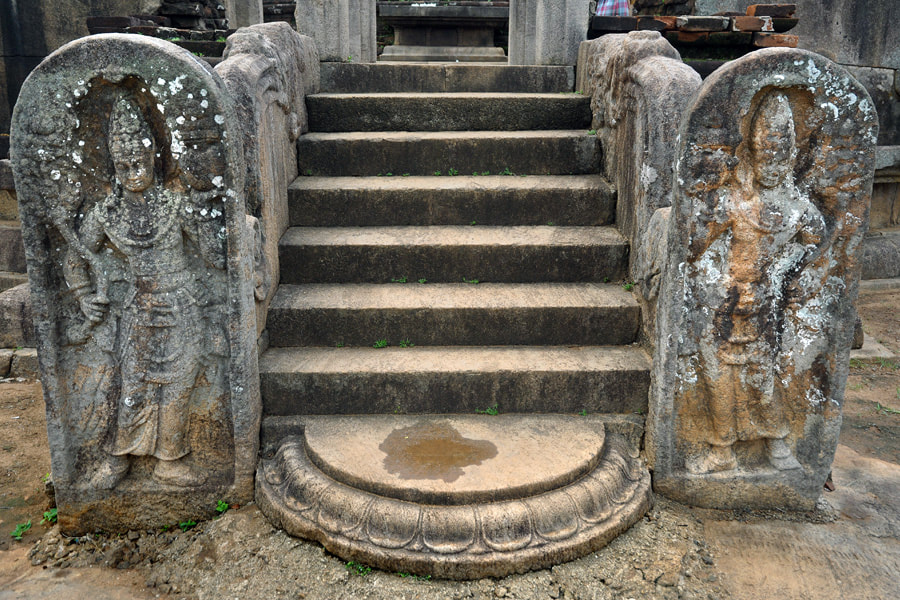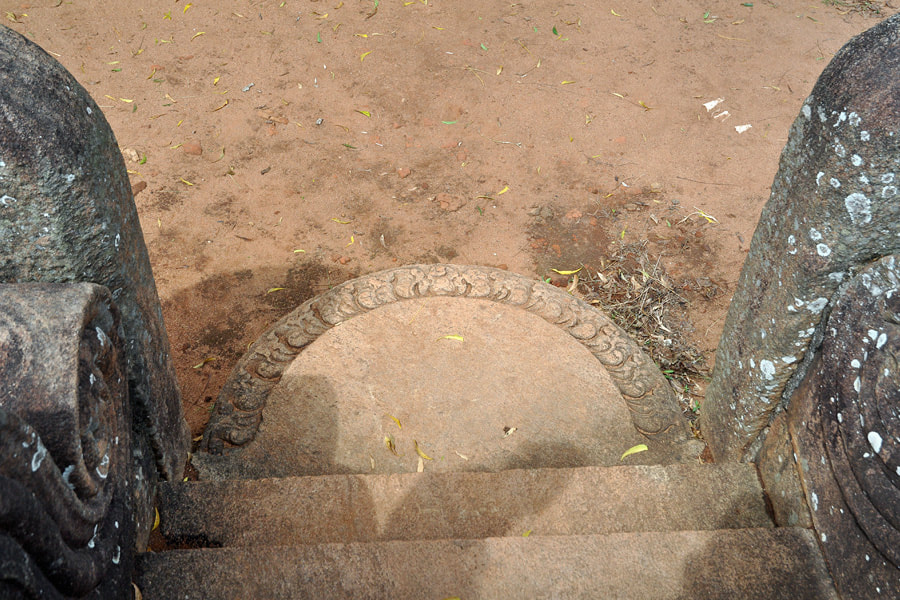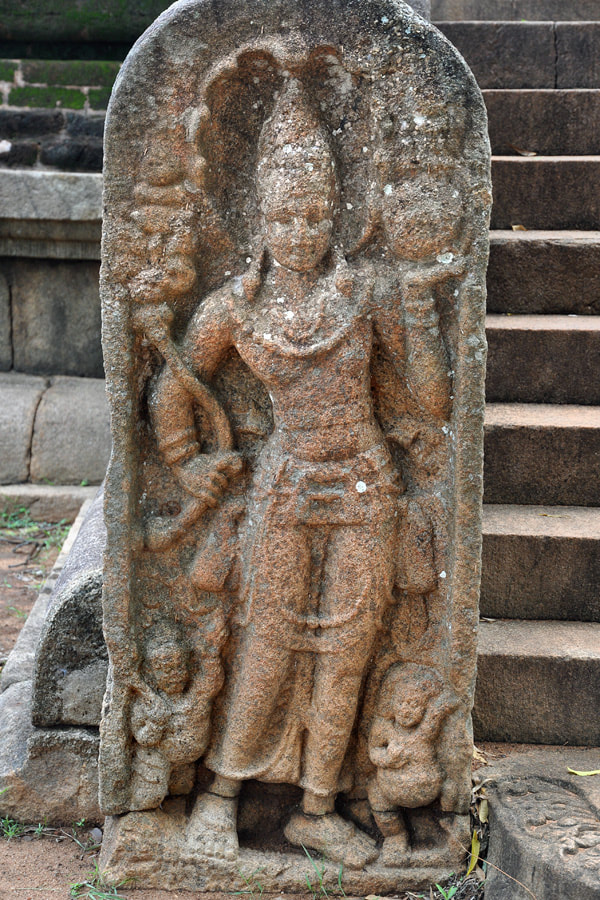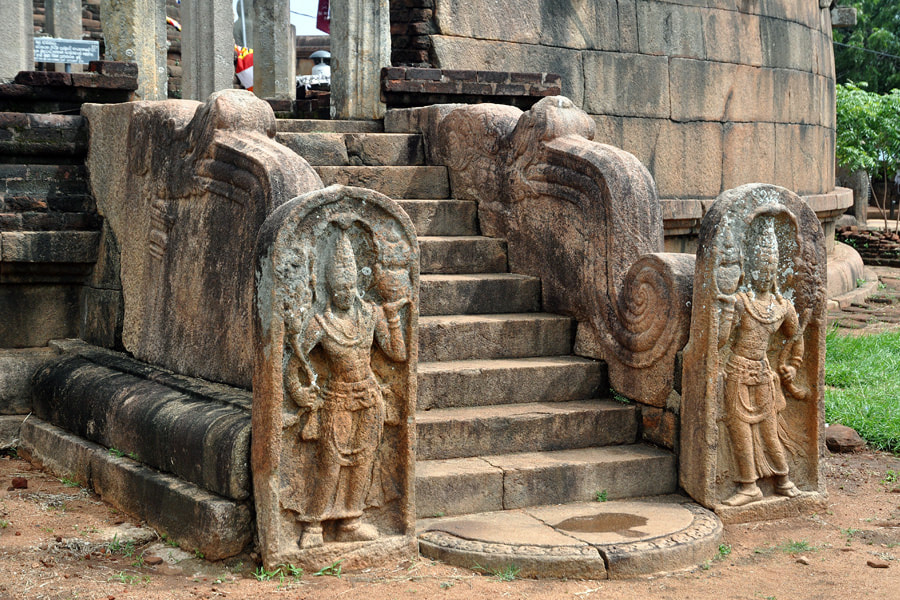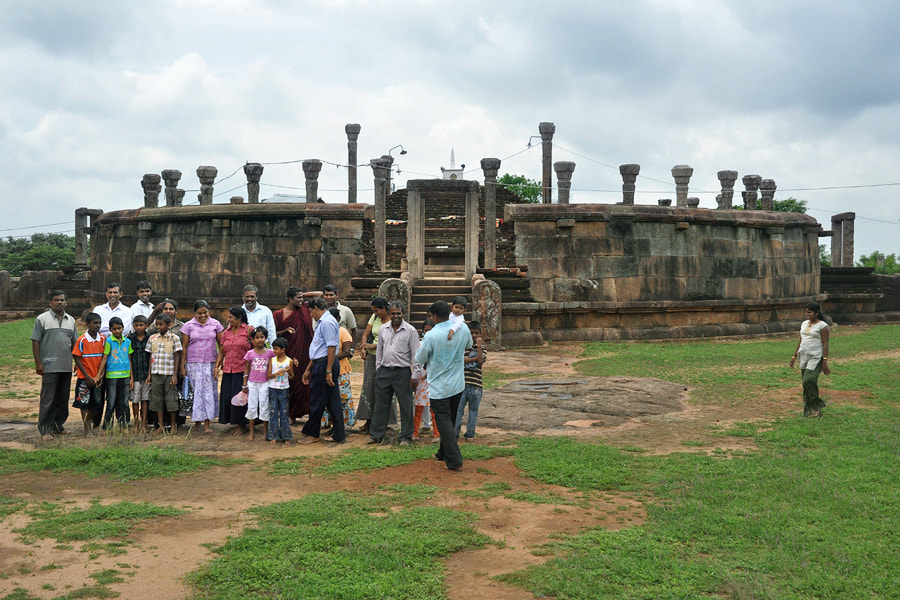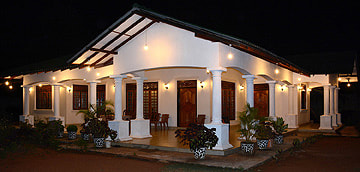Thiriyai still is an off-the-beaten-path destination, although its worth visiting indeed: It’s both the most important and the most beautiful archaeological site of the Eastern Province. Along with Kudumbigala 250 km further south, Thiriyai is certainly one of the most charming ancient temples along Sri Lanka‘s eastern coastline, just due to its location on a hill overlooking the sea, which is only four kilometers away. In terms of cultural history, Thiriyai is unrivaled in eastern Sri Lanka, because of its classical circular temple. It would deserve more than other Sri Lankan candidates to be included in the list of World Heritage Sites. This somewhat brisk introduction already reveals that Thiriyai is one of our favorite places, we highly recommend travellers to visit it when staying in Trincomalee District. The following presentation also serves to make aware of both the beauty and significance of this historical site, which is still off the beaten path. Though not being a proposal for UNESCO listings, our article may serve as a suggestion for itineraries of study trips.
Content of our Thiriyai page:
Name - Location - Natural Setting - Girikandi Legend
History: Tamil Buddhism and Mahayana - Confluence of Traditions in the Art of Thiriyai
Places of interest: Ancient Stone Bridge - Pokuna - Pillars - Monastery ruins - Padhanagara
Highlights on the Summit: Circular Temple called Girihandu Seya - Moonstones - Muragals - Vatadage Interior
Name - Location - Natural Setting - Girikandi Legend
History: Tamil Buddhism and Mahayana - Confluence of Traditions in the Art of Thiriyai
Places of interest: Ancient Stone Bridge - Pokuna - Pillars - Monastery ruins - Padhanagara
Highlights on the Summit: Circular Temple called Girihandu Seya - Moonstones - Muragals - Vatadage Interior
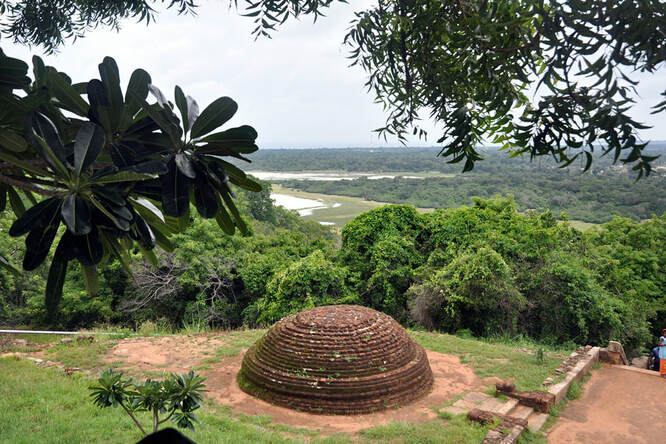
Thiriyai, also known as Tiriyai or Tiriyaya or Thiriyaya, is a village at Sri Lanka’s East Coast, situated 42 km north of Trincomalee. On a hill in Thiriyai's hinterland is a Buddhist temple and archaeological site comprising Girihadu Seya, Sri Lanka’s best preserved Vatadage from the Anuradhapura period. Vatadages are circular temples enshrining small stupas. This specific form has become typical of Sri Lanka's classical Buddhist architecture. The outer ring wall is even better preserved than that of the much more famous Vatadage of Polonnaruwa, though the Vatadage of Thiriyai is 400 years older. Legend has it is at this place that a hair relic was enshrined by the Buddha's first two lay followers, namely the merchants Tapussa and Bhallika. The archaeological site of Thiriyai is one of the most interesting archaeological sites in Sri Lanka. Apart from the said highlight for today's travellers interested in cultural history, viz. the circular temple on the top of the hill, there are excavations of an entire early medieval monastery.
Remarkably, Tamils played a crucial roles in the construction of the ancient Buddhist temple of Thiriyai. Though this seems to be almost forgotten in today's guidebooks, which tend to project a modern dividing line between the Buddhist Sinhalese culture and the Hindu Tamil culture into the classical periods of these two neighbouring civilizations, in fact many Tamil merchants trading along the shores of the Gulf of Bengal during the entire first millennium were Buddhists and not Hindus. It is noteworthy that this Buddhist sanctuary in today's Tamil area was once not only co-founded by Tamil Buddhists but also influenced by the Pallava style, which marks the period of the classical Tamil art in mainland India. Decoration elements, particularly the oldest Nagaraja doorkeeper sculptures of Sri Lanka, are indicative of a transfer of elements of southindian art to the island.
Remarkably, Tamils played a crucial roles in the construction of the ancient Buddhist temple of Thiriyai. Though this seems to be almost forgotten in today's guidebooks, which tend to project a modern dividing line between the Buddhist Sinhalese culture and the Hindu Tamil culture into the classical periods of these two neighbouring civilizations, in fact many Tamil merchants trading along the shores of the Gulf of Bengal during the entire first millennium were Buddhists and not Hindus. It is noteworthy that this Buddhist sanctuary in today's Tamil area was once not only co-founded by Tamil Buddhists but also influenced by the Pallava style, which marks the period of the classical Tamil art in mainland India. Decoration elements, particularly the oldest Nagaraja doorkeeper sculptures of Sri Lanka, are indicative of a transfer of elements of southindian art to the island.
Name of Thiriyai
By native Tamils, "Thiriyai" is pronounced just in the way it is written in Latin letters. However, another very common spelling is "Tiriyai". "Tiri" is the Tamil prefix for "holy", which is often found in names of temples and places of pilgrimage names. In this respect, it‘s quite similar to the Sanskrit term "Sri". "Yaya" means "rice land", indicating a more intensive use of this area in ancient times. Today, many lands in this areas are fallow or used for grazing.
|
KandaswamimalaiLocal Tamils sometimes call the hill Kandaswamimalai, "Skanda Mountain," although there is no place of worship for that specific god on the hill. That Tamil name is a little bit provocative for Buddhists. Skanda, better known as Murugan in Tamil regions, was originally a mountain god and therefore is often worshipped on hills. However, traces of an ancient Murugan cult are not yet known from the Thiriyai Hill. It has clearly been a Buddhist sanctuary. |
Location of Thiriyai
Thiriyai is situated 45 km north of Trincomalee. The coastal road has been very well developed after decades of civil war in this region. Previously, it has been required to go by ferry twice when travelling from Trincomalee to Thiriyai. But the ferries have been replaced by modern bridges since the end of the Civil War. At the village of Thiriyai, the visitor of the ancient site of the same name has turn off to the left and then after about 1 km again turn to the right. The small road leads to the Buddhist monastery. In 2010, the road run along the building of a former police station that was destroyed by an LTTE raid.
|
civil war region till 2009
The indigenous Sinhala minority was systematically expelled by terrorist militia from the area near Thiriyai and north of it, just as from the Northern Province of the island. Enforcedly, many monks also left the Buddhist sanctuary located in the Tamil area.
Even the monastery of Thiriyai was once the setting of hostilities during the years of civil war. However, the famous circular temple, which is the main attraction of Thiriyai, was not affected by that incidents.
Facing the dangerous situation, a Buddhist monk has almost always stayed at the sanctuary. Some other monks who remained at their Buddhist temples within the civil war area fell victim to assault. They were even a preferred target of terrorist attacks due to the symbolism of the yellow robe.
Nowadays, several monks have settled at the foot of the Thiriyai hill, but most of them came from the south of Sri Lanka. Sinhala pilgrims have rediscovered this charming holy place, too.
Even the monastery of Thiriyai was once the setting of hostilities during the years of civil war. However, the famous circular temple, which is the main attraction of Thiriyai, was not affected by that incidents.
Facing the dangerous situation, a Buddhist monk has almost always stayed at the sanctuary. Some other monks who remained at their Buddhist temples within the civil war area fell victim to assault. They were even a preferred target of terrorist attacks due to the symbolism of the yellow robe.
Nowadays, several monks have settled at the foot of the Thiriyai hill, but most of them came from the south of Sri Lanka. Sinhala pilgrims have rediscovered this charming holy place, too.
Wildlife in the hinterland of Thiriyai
Today, there are huts and stalls selling tea and fresh baked goods for pilgrims. The area is safe, this is to say: there is no mine threat within the archaeological site.
However, there is another kind of danger, namely wild animals. The monastery belongs to the transition zone between the village area and the jungle in the hinterland of Thiriyai. The wildlife area includes two small lakes, which attracts not only deers but also bears and leopards. At dusk, elephants sometimes even enter the monastery grounds, attracted by the the ponds of the historical site. Once a young elephant that could not be driven away and and also behaved in an aggressive way was shot by a ranger, with approval of the authorities. The skull with the bullet hole can still be seen near the new monastery buildings.
However, there is another kind of danger, namely wild animals. The monastery belongs to the transition zone between the village area and the jungle in the hinterland of Thiriyai. The wildlife area includes two small lakes, which attracts not only deers but also bears and leopards. At dusk, elephants sometimes even enter the monastery grounds, attracted by the the ponds of the historical site. Once a young elephant that could not be driven away and and also behaved in an aggressive way was shot by a ranger, with approval of the authorities. The skull with the bullet hole can still be seen near the new monastery buildings.
Another typical inhabitant of the dry zone of Sri Lanka is less dangerous, at least as long as you do not harass it, the Bengal monitor. (The specimen depicted on the right photo is not yet fully grown).
Gal Palama: Ancient Stone Bridge at the foot of Thiriyai hill
Not far from the car park and within the compound of the new monastery, there is an an ancient stone bridge at the foot of Thiriyai Hill. These seemingly stone-age-constructions were actually built during the Anuradhapura period.
Sri Lanka once was home to several dozens of such stone bridges. They are usually called Gal Palama, which is just the Pali term of the same meaning as stone bridge. Sri Lanka’s Gal Palamas resemble stone age bridges or at least bronze age bridges (e.g. Tarr Steps in Exmoor in southwestern England). But, as said, they are from a historical period, namely the first millennium AD. Such bridges were constructed all over the island. However, only a few are as well preserved as this small one in Thiriyai.
|
Surprisingly, the elaborate constructions are not mentioned in the Buddhist chronicles which otherwise meticulously record every kind of building activity. The reason for the omission may be that stone bridged were built by local communities instead of kings or that they are of less religious significance than dams and channels, the construction of which is emphasized as a religioes merit. Whatever Buddhist rulers carried out for the benefit of their subjects, is worth mentioning in the chronicles. But they ofter ignore the relevance of regional and local levels of self-government, despite the fact that the latter are of even higher significance in the history of Sri Lanka than in other Asian cultures. The best preserved example of a Gal Palama can be found at Mihintale, 80 miles to the southwest. |
History of Thiriyai
Although the stupa on the summit of Thiriyai may well have been founded during the very early period of the Anuradhapura kingdom in pre-Christian centuries, those remains of the buildings visible today date back to the 8th or 9th century AD. In particular, the striking Sinhalese circular temple known as Girihandu Seya is from this late Anuradhapura period. Later on, King Vijayabahu had the complex renovated following the expulsion of Sri Lanka's South Indian Cholas in the second half of the 11th century. Sacred buildings, particularly in this region, then were damaged again by the invasion of the marauding foreign army of Kalinga Magha in the first half of the 13th century.
for more historical background information click here
It may well be the case that Thiriyai had been a sacred site even in pre-Buddhist times. Tamil Hindus like to claim the sanctuary as their own cultural heritage, as mentioned above. Although there are no traces of the typical Tamil Hindu cult of Murugan alias Skanda or of veneration of Shiva, it is no odd hypothesis that Thiriyai could habe been a Tamil sanctuary originally - but a Buddhist one. How can that be? Sri Lankan Tamils are Hindus, while Buddhists in Sri Lanka are always Sinhalese, aren’t they? Well, today that’s the case indeed. But in the first millennium, when Thiriyai was constructed, the division lines were not as clear as today. Undeniably, Buddhism played a crucial role in the development of Tamil culture in mainland India during the first half of the first millennium BC. Tamil Buddhism was part of an ongoing cultural exchange between India and the Sinhalese kingdom of Anuradhapura. For example, Buddhagosa and Buddhadatta, the classical commentators of the Holy Scriptures, still revered as two superior authorities of today's Theravada Buddhism, were Tamils from the mainland, who conducted their studies and put down their writings in the Sinhalese capital Anuradhapura.
This largely harmonious interaction gradually changed into religious contrasts during the second half of the millennium, although Buddhist works of art continued to be a significant part of Tamil culture during this classical period of Pallavas, Pandya, and Cholas. The dawn of the triumph of Hinduism among South Indian Tamils in those early Middle Ages was marked by the Pallava dynasty. Originally, the Pallavas were local rulers reigning further north, namely in the area of the Andhras. They already were a rising power in the first half of the millennium, when the Buddhist dynasty of the Ikshvakus was in decline. Both dynasties previously had been those of princes as regional rulers under the supremacy of the Shatavahana Empire, which had also taken great cultural influence on Sri Lanka, Amaravati being the major hub of Buddhist culture during that period. After its decline, Nagarjunakonda, the capital of the Ikshvakus, gained a comparably significant position in South Indian Buddhism. In the middle of the 4th century, the Pallavas, who rivaled the Ikshvakus, began to dominate in the Krishna-Godavari delta (in Andhra, north of Tamil Nadu). From the 4th century onwards, the Pallavas also controlled Kanchi, which should become the shining capital of the first Tamil empire later on. The Pallavas initially favoured a monks’s religion which was a competitor of Buddhism in India, namely Jainism. Already during the early period of Pallava rule, in the first half of the millennium, the center of power of the Pallavas moved to the south, as mentioned. Their new capital Kanchi aka Kanchipuram belongs to the Tamil heartland. Now, what’s the reason for telling the story of the Pallavas when dealing with Tamil Hinduism and with Sri Lanka’s Buddhism and the site Thiriyai?
Well, there was a significant change of religion of the Pallava rulers. Only afterwards, they developed into the hegemonic dynasty of the Tamil region. The first great king of the Pallava empire was Mahendravarman I (571-630). By the way, one of his close friends serving at his court in Kanchi in southern India was Manavanna, the later king of Sri Lanka and founder of the long ruling last dynasty of Anuradhapura kings. The difference of their religions did not affect their alliance in a negative way, as both the Buddhist Sinhalese and the Hindu Pallavas in southern India simply had a common enemy at that point in time, namely the Tamil kingdom of the Pandyas, situated just in between their spheres of control. Under the said Pallava ruler Mahendravarman, literature and architecture and sculptural art flourished in southern India and influenced neighbouring regions, too. The Pallava art is the paragon of temple architecture in the southern half of India till the present day, as it marks the first period of the so-called Dravidian style of Hindu temples. Moreover, via overseas trade, the Pallava style spread even to Southeast Asia.
The rise of the Hindu religion and art under Pallava rule is interrelated to the conversion of King Mahendravarman from Jainism to Shaivism, an event he recorded in a famous inscription in the rock temple of Tiruchirapalli. This became a crucial date for the dominance of the Shiva religion among Tamils. Though indirectly, there were also repercussions in Sri Lanka's Eastern Province:
Tamil Jains and Tamil Buddhists were beset with the Shiva preference of their ruler. Although they were not persecuted systematically, their monasteries were affected significantly, since they lost royal protection and support at least. Nevertheless, Buddhism continued to play an important role among Tamils, particularly among merchant guilds in overseas ports of the Pallavas. Associations of traders had always been closely connected to the Buddhist order, as both groups shared a transregional character. Due to the now reduced religious scope in the Tamil homeland in southern India, the Tamil merchants founded or supported Buddhist shrines overseas, mainly in Southeast Asia but also in Sri Lanka. Along the east coast of the island, there are several Buddhist inscriptions in Tamil language from the Pallava period accordingly.
This largely harmonious interaction gradually changed into religious contrasts during the second half of the millennium, although Buddhist works of art continued to be a significant part of Tamil culture during this classical period of Pallavas, Pandya, and Cholas. The dawn of the triumph of Hinduism among South Indian Tamils in those early Middle Ages was marked by the Pallava dynasty. Originally, the Pallavas were local rulers reigning further north, namely in the area of the Andhras. They already were a rising power in the first half of the millennium, when the Buddhist dynasty of the Ikshvakus was in decline. Both dynasties previously had been those of princes as regional rulers under the supremacy of the Shatavahana Empire, which had also taken great cultural influence on Sri Lanka, Amaravati being the major hub of Buddhist culture during that period. After its decline, Nagarjunakonda, the capital of the Ikshvakus, gained a comparably significant position in South Indian Buddhism. In the middle of the 4th century, the Pallavas, who rivaled the Ikshvakus, began to dominate in the Krishna-Godavari delta (in Andhra, north of Tamil Nadu). From the 4th century onwards, the Pallavas also controlled Kanchi, which should become the shining capital of the first Tamil empire later on. The Pallavas initially favoured a monks’s religion which was a competitor of Buddhism in India, namely Jainism. Already during the early period of Pallava rule, in the first half of the millennium, the center of power of the Pallavas moved to the south, as mentioned. Their new capital Kanchi aka Kanchipuram belongs to the Tamil heartland. Now, what’s the reason for telling the story of the Pallavas when dealing with Tamil Hinduism and with Sri Lanka’s Buddhism and the site Thiriyai?
Well, there was a significant change of religion of the Pallava rulers. Only afterwards, they developed into the hegemonic dynasty of the Tamil region. The first great king of the Pallava empire was Mahendravarman I (571-630). By the way, one of his close friends serving at his court in Kanchi in southern India was Manavanna, the later king of Sri Lanka and founder of the long ruling last dynasty of Anuradhapura kings. The difference of their religions did not affect their alliance in a negative way, as both the Buddhist Sinhalese and the Hindu Pallavas in southern India simply had a common enemy at that point in time, namely the Tamil kingdom of the Pandyas, situated just in between their spheres of control. Under the said Pallava ruler Mahendravarman, literature and architecture and sculptural art flourished in southern India and influenced neighbouring regions, too. The Pallava art is the paragon of temple architecture in the southern half of India till the present day, as it marks the first period of the so-called Dravidian style of Hindu temples. Moreover, via overseas trade, the Pallava style spread even to Southeast Asia.
The rise of the Hindu religion and art under Pallava rule is interrelated to the conversion of King Mahendravarman from Jainism to Shaivism, an event he recorded in a famous inscription in the rock temple of Tiruchirapalli. This became a crucial date for the dominance of the Shiva religion among Tamils. Though indirectly, there were also repercussions in Sri Lanka's Eastern Province:
Tamil Jains and Tamil Buddhists were beset with the Shiva preference of their ruler. Although they were not persecuted systematically, their monasteries were affected significantly, since they lost royal protection and support at least. Nevertheless, Buddhism continued to play an important role among Tamils, particularly among merchant guilds in overseas ports of the Pallavas. Associations of traders had always been closely connected to the Buddhist order, as both groups shared a transregional character. Due to the now reduced religious scope in the Tamil homeland in southern India, the Tamil merchants founded or supported Buddhist shrines overseas, mainly in Southeast Asia but also in Sri Lanka. Along the east coast of the island, there are several Buddhist inscriptions in Tamil language from the Pallava period accordingly.
Mahayana Buddhism in Thiriyai
It was a specific version of Buddhism that was popular among those Tamil merchants that frequently visited the eastern shores of Sri Lanka and formed a part of the local communities, namely Mahayana Buddhism, which during that period gave lay piety greater relevance than the monastically organized Theravada Buddhism of the Sinhalese Anuradhapura kingdom. In this very period of "exporting" Tamil Buddhism overseas, Mahayana had its great impact on Sri Lanka’s sculptural art.
for more evidence of Mahayana influence click here
Most of the famous shrines in the east and south of the island and the giant Buddha Staues prove the influence of Mahayana in the late Anuradhapura period. The influence is even evident in the region of Anuradhapura. The classical Sinhalese relief art of the Theravada hub Anuradhapura dates back to this very period of the 7th to the 10th century. From then on the motif of the Nagaraja stele has become the typical Sinhalese version of Indian guard stones. The specific design has to be mentioned below again, as Thiriyai is home to the oldest well-preserved specimens of fully elaborate Nagaraja guardstones. Furthermore, Thiriyai, which of course was very much exposed to Indian influences due to ist location near the ports of the north and east, also proved to be a veritable treasure trove of bronzes which clearly represent Mahayana figures.
There is the best possible archaeological evidence for the involvement of Tamils at the time of the construction of the temple of Thiriyai around the 8th century, viz. epigraphical evidence. In Thiriyai, a large rock inscription in Sanskrit dates back to the 8th century. To be sure, Sanskrit is not Tamil. But contemporary Sinhalese-Buddhist inscriptions are written in the Pali language and younger ones also in Sinhala, but usually not in Sanskrit. Sanskrit, the holy language of Brahmin priests and classical language of court poets, on the other hand, had long since become the literary language of Buddhists in India, too. Many Sanskrit inscriptions for religious purposes are known from the Tamil area of southern India. The characters of the Thiriyai inscription are not variants of the Sinhalese script, but of the Grantha alphabet, which was commonly used for inscriptions in Tamil regions of India during that period, particularly for Sanskrit inscriptions. The content of the Thiriyai inscription is a dedication to the Bodhisattva Avalokiteschwara and his female companion Tara. These are the two most revered beings in Mahayana Buddhism.
Thiriyai was almost certainly a Mahayana sanctuary. That does not exclude that it was a Theravada sanctuary at the same time. Both varieties of Buddhism often existed side by side in the very same monastery, for example in the Nalanda university in Bihar, the Buddhist heartland, which roughly covers the area of the ancient Magadha. The same was the case in the Abhayagiri monastery in Anuradhapura, which was the largest Sinhalese religious instituton those days. Both Theravada and Mahayana manuscripts and teachings were studied there.
There is the best possible archaeological evidence for the involvement of Tamils at the time of the construction of the temple of Thiriyai around the 8th century, viz. epigraphical evidence. In Thiriyai, a large rock inscription in Sanskrit dates back to the 8th century. To be sure, Sanskrit is not Tamil. But contemporary Sinhalese-Buddhist inscriptions are written in the Pali language and younger ones also in Sinhala, but usually not in Sanskrit. Sanskrit, the holy language of Brahmin priests and classical language of court poets, on the other hand, had long since become the literary language of Buddhists in India, too. Many Sanskrit inscriptions for religious purposes are known from the Tamil area of southern India. The characters of the Thiriyai inscription are not variants of the Sinhalese script, but of the Grantha alphabet, which was commonly used for inscriptions in Tamil regions of India during that period, particularly for Sanskrit inscriptions. The content of the Thiriyai inscription is a dedication to the Bodhisattva Avalokiteschwara and his female companion Tara. These are the two most revered beings in Mahayana Buddhism.
Thiriyai was almost certainly a Mahayana sanctuary. That does not exclude that it was a Theravada sanctuary at the same time. Both varieties of Buddhism often existed side by side in the very same monastery, for example in the Nalanda university in Bihar, the Buddhist heartland, which roughly covers the area of the ancient Magadha. The same was the case in the Abhayagiri monastery in Anuradhapura, which was the largest Sinhalese religious instituton those days. Both Theravada and Mahayana manuscripts and teachings were studied there.
Fusion of Sinhalese and Tamil art in Thiriyai - instead of ethnic exclusivism
May that be so, the Sinhala Buddhist cultural patriot does not need to feel offended by the hypothesis that Tamils played a crucial role in shaping this great Buddhist sanctuary. To many chauvinists of colonial and post-colonial times, however, Thiriyai is considered a prove of Sinhala Buddhist dominance in the east of the island in ancient times, whereas the Eastern Province today belongs to a mainly Tamil speaking area and in historical times has always been exposed to Tamil cultural influences. Nevertheless, even cultural warriors are still reasonably right when claiming Thiriyai for the Sinhala culture – but they mistakenly project a sharp dividing line between Buddhist Sinhalese and Tamil Hindus into a distant past. It’s true, the sanctuary of Thiriyai is Sinhalese and Buddhist. But maybe this is simply not the entire story of Thiriyai. Buddhist Tamils, according to the hypothesis presented here, played a decisive role in creating this temple in the 8th century. The art of Thiriyai is both Sinhala and Tamil at the same time, as can be seen when taking into account the two most striking aspects of the architectural form - the Vatadage - and sculptural decoration - the Nagaraja steles.
Being both Sinhalese and Tamil is not a contradiction in terms. The confluence of the two cultures was quite normal, not an exception. For example, many of the Tamils of the Anuradhapura period, whose families settled permanently as peasants in Sri Lanka, adopted the Sinhalese language after a few generations. That is to say, many Tamils became Sinhalese steadily - although already in the Anuradhapura period there were also Hindu communities along the East Coast that remained Tamil-speaking. Again: The Buddhists of the Thiriyai complex that is discussed here, were Tamil traders intimately connected to Southern India.
|
In Thiriyai, according to the hypothesis favoured here, Sinhalese influences such as the striking architectural pattern of a circular temple typical of the interior parts of the island merged with sculptural art of Tamil origin, a South-Indian inspiration embraced by Sinhalese artists during the final phase of the classical Anuradhapura period. Thus, Thiriyai‘s fusion of arts from various cultures had repercussions on the heartland of the Sinhalese civilization, epigraphically recorded in Mihintale and concerning sculptural decoration detectable in the fine arts of Anuradhapura.
|
According to this hypothesis, Thiriyai is both a mediator of Tamil inspiration from the Pallava relief art of South India to the Sinhalese core area of Sri Lanka and, on the other hand, a mediator bringing Sinhalese architectural forms to the Tamil culture at the northeastern coast of Sri Lanka.
Excursus: Fusions and Interrelations instead of distinctions
However, this hypothesis may well be an unwelcome interpretation of Thiriyai for cultural-chauvinists of both sides, because patriots of both sides, who are more concerned with dividing lines, tend to claim cultural achievements only for one side, not viz. their own own. But the truth is: In the eastern region of the island there was neither a purely Tamil culture which was isolated from the Sinhala kingdom during the Anuradhapura period nor, in a very complementary way, was the classical Sinhalese civilization, even in ist core region that likes to be called Cultural Triangle today, concerned with distancing itself from Southindian culture. Quite the contrary, it has been shaped by Tamil influences in many ways.
Thus, if there is some truth in the hypothesis presented here, Thiriyai is truly a very exciting and remarkable place for the cultural history of Sri Lanka, not a monument of Sinhalese domination in the Tamil area, but a monument of Tamil-Sinhalese interaction and the irrelevance of ethnic boundaries in pre-colonial history. Particularly modern Asian elites educated in a western way of thinking tend to pigeonholing. Ironically, even their upholding of Asian versus Western values is actually a westernized ideology. The original Asian way of thinking – the Buddhist insight in particular - was not that of identities and compartmentalization but that of interdependency.
Thus, if there is some truth in the hypothesis presented here, Thiriyai is truly a very exciting and remarkable place for the cultural history of Sri Lanka, not a monument of Sinhalese domination in the Tamil area, but a monument of Tamil-Sinhalese interaction and the irrelevance of ethnic boundaries in pre-colonial history. Particularly modern Asian elites educated in a western way of thinking tend to pigeonholing. Ironically, even their upholding of Asian versus Western values is actually a westernized ideology. The original Asian way of thinking – the Buddhist insight in particular - was not that of identities and compartmentalization but that of interdependency.
Sightseeing at the archaeological site of Thiriyai
|
The main sanctuary on the summit is still a travel destination of Buddhist pilgrims. As mentioned, the location of the temple on a hilltop is also one reason why it‘s an attractive destination for modern tourists interested in the island’s heritage.
The stairway to the ancient site begins just behind the two ponds separating the hill from the compound of the new monastic buildings and the stone bridge. The well-built staircase to the hill sanctuary is said to habe 280 steps leading to the hill sanctuary. Maybe, the hike is a little bit exhausting in the tropical heat, but it’s certainly not an extreme physical challenge, the level of strenuousness is comparable to that reaching the Dambulla caves. Halfway to the tip the visitor can find Brahmi inscriptions, just above a narrow rocky outcrop. The style of the characters as ell eas the content allow to attribute the inscription to roughly the time of Christ's birth. |
The short text reads: "Cave of Prince Uttiya's Daughter and cave of Pigala Anudi for the Sangha of the Four Cardinal Directions." The latter term, also translated as "Sangha of the Four World Regions," is the official name of the Buddhist Order. In the early phase of Buddhism on the island, donations were usually made to the entire Order. It was not before the middle Anuradhapura period that individual monks are mentioned as beneficiaries. However, that it is not a king or a prince who set up the inscription but only a lowe-ranking member of a royal family, would be atypical of the oldest Brahmi inscriptions from the time of the introduction of Buddhism in the 3rd century BC. That's why this Thiriyai inscription is dated to a slightly later period of early Sri Lankan Buddhism. It is remarkable, of course, that it‘s a woman who is mentioned as the benefactor.
Pokuna of Thiriyai
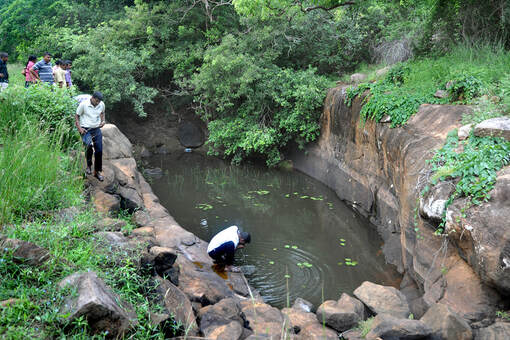 natural Pokuna at the northeastern slope of the Thiriyai hill
natural Pokuna at the northeastern slope of the Thiriyai hill
Reaching a small platform after three-quarters of the flight of steps, the steep upper part of stairway is on the left, this very last section of the stairs leads to the circular temple enclosing the main dagoba on the summit. Instead of going there directly, the visitor can can walk a narrow path running straight ahead at this turn of the staircase, then arriving at a deep artificially widened waterhole in the rock, it’s almost always filled with water, even during the local dry period in northern hemisphere summer months. It may also have served as a bathing pool of the ancient monastery, a so-called Pokuna.
Stone pillars of the monastic complex
Continuing to walk the small jungle path straight ahead, the visitor will finally reach the older northern access to the summit. Here, within a shallow saddle of the northern slope, there are scattered remnants of typical buildings of an early medieval forest monastery.
|
The monolithic pillars of this monastic area are noteworthy in particular. They are decorated with cubic bulges, which are designed in analogy to wooden columns of classical Kandyan style of Sri Lankan architecture. The chapiters too resemble those of wooden columns of the Kandyan period. The picture below shows four stone pillars once belonging to a gateway in front of the northern stairway to Thiriyai's summit.
|
Stone columns of this style were actually the models for the wooden pillars of the Kandyan period, from which some striking specimen are well-known. This kind of intermediate blocks is typical of Kandy’s representative wooden architecture of Kandy. The surfaces of such cubic bulges are often decorated with reliefs. Kandyan art is famous for these woodcarvings (see Embekke or Panavitiya). The wooden pillars of the Kandyan period were definitely inspired by the earlier stone pillars from the Anuradhapura and Polonnaruwa periods. In turn, these ancient and medieval stone pillars were almost certainly inspired by wooden architecture that, due to decomposition in the tropical climate, has not survived. Specimen of wooden architecture from more than a thousand years ago are not preserved in Sri Lanka. Actually, all surviving wooden structures on the island are less than 500 years old. Likewise, the form of the stone capitals will reappear in Kandyan wooden art, particularly the highly stylized, four-fold hanging lotus. But in Kandyan architecture, the wooden chapiters depict half-open flowers. |
Northern monastic complex of Thiriyai
The center of the monastery is a veritable courtyard, with shirt stairways down into it from all four sides down, flanked by small guardian steles. The staircases to the image houses of the monastery are flanked by very simple Makara balustrades.
On the northern side of this courtyard is a quite peculiar building, the two platforms of which are connected by a broad and flat monolith, which, like the other paving stones, is massive and nevertheless levelled and slightly burnished. This elaborate works of stone carving are striking within this complex of otherwise not very large-sized and almost undecorated buildings. The said building looks like an en-miniature version of meditation platforms from the same period which are also designed as double platforms. The latter are known from forest monasteries. Their specific architectural form can be studied at another building just next to the said group surronding the coutyard:
Padhanagara of Thiriyai
On the western edge of the central monastic area there is a typical meditation platform, more precisely: a double platform with a stone bridge, a so-called Padhanagara.
Excursus: Traces of Pansukulika Architecture in Thiriyai
Padhanagara architecture of the Pansukulika fraternity
Padhanagaras, the two terraces of which are connected by a bridge, are actually an innovation of a specific monastic reform movement, the Pansukulikas. They were a strict ascetic order of forest monks, the heyday of the movement being the 8th to 10th centuries. In addition to bathing ponds and hospitals, Padhanagara platforms are the only elaborate works of architecture within their monasteries. In Pansukulika monasteries, the said forms of buildings completely replaced the traditional edifices of a Buddhist sanctuary, namely stupa, picture house, Bo-tree terrace and chapter house, all of which are abent in pure Pansukulika complexes such as Ritigala or Arankale. For ceremonial purposes, their typical double platforms replaced the four classical elements of a Sinhalese monastery in the following way. Instead of veneration of relics, statues and trees now the assembly platform of monks was honoured by laymen by circumambulating it. The monks sat on the rearward terrace of such a double platform, while the front terrace of the Padhanagaras served as the lobby for visitors, who were granted audience. Here the laymen could depose their gifts, keeping respectful distance from the monks on the other side of the bridge, but close enough to listen to their advice. In the largest Padhanagaras of the Pansukulika Monastery, a courtyard is created for subsequently persued circumambulations of the meditating group of monks, who were holding ceremonies or granting audiences. The pilgrims were walking aroung the double platform paying respect to the monks in the same way as they would do to relics enshrined in stupas or Buddha images in image houses or trees in tree kouses. Lateral stairs led down from the bridge into this courtyard corridor for circumambulation of the main platform.
However, the small Padhanagara in Thiriyai has neither a courtyard for circumambulations nor a staircase at the bridge. It was not necessary here, because Thiriyai was a normal Buddhist sanctuary, with statues to be venertated by the pilgrims and, above all, the stupa on the summit. The traditional elements of Buddhist were to be circumambulated. In the case of Thiriyai, double platform was not designed for the worship of the order of the monks, the Sangha, as in case of actual Pansukilika monasteries, but just for the original purpose of such a platform, viz. the undisturbed meditation of monks.
It wa not uncommon that other monasteries that did not follow the strict Pansukulika rules nevertheless adopted this characteristic type of Padhanagara double platform for the purposes of undisturbed spiritual practice. Other examples of normal (non-Pansukulika) forest monasteries including stupas and statues and Bo-tress for traditional ways or relic, image and tree worship, that also integrated Padhanagara platforms are found in Mihintale and Hatthikucchi.
However, the small Padhanagara in Thiriyai has neither a courtyard for circumambulations nor a staircase at the bridge. It was not necessary here, because Thiriyai was a normal Buddhist sanctuary, with statues to be venertated by the pilgrims and, above all, the stupa on the summit. The traditional elements of Buddhist were to be circumambulated. In the case of Thiriyai, double platform was not designed for the worship of the order of the monks, the Sangha, as in case of actual Pansukilika monasteries, but just for the original purpose of such a platform, viz. the undisturbed meditation of monks.
It wa not uncommon that other monasteries that did not follow the strict Pansukulika rules nevertheless adopted this characteristic type of Padhanagara double platform for the purposes of undisturbed spiritual practice. Other examples of normal (non-Pansukulika) forest monasteries including stupas and statues and Bo-tress for traditional ways or relic, image and tree worship, that also integrated Padhanagara platforms are found in Mihintale and Hatthikucchi.
Small summit plateau of Thiriyai
Let's finally turn to Thiriyai’s main attraction, the terrace on the top, where the well-preserved circular stupa-house is situated. It’s accessible also from the above-mentioned monastic abbey ruins on the north slope, as a restored ancient stairway leads to the summit plateau of the sacred hill, which definitely was and is the most sacred site of the temple complex .
The artificially leveled summit of the hill of Thiriyai covers an area of about half a hectare. The entire terrace is enclosed by a wall.
The circular temple of Thiriyai is also known by the poetic name "Akasachetiya", meaning "heavenly stupa", obviously an allusion to its location on a peak - albeit this heavenly mountain is not very tall. Nonetheless, the location of the circular temple is a charming site deserving celestial names inded. It’s also a good vantage point. overlooking the surrounding plains, the wilderness of Trincomalee District to the west and the village and agricultural area to the east.
The artificially leveled summit of the hill of Thiriyai covers an area of about half a hectare. The entire terrace is enclosed by a wall.
The circular temple of Thiriyai is also known by the poetic name "Akasachetiya", meaning "heavenly stupa", obviously an allusion to its location on a peak - albeit this heavenly mountain is not very tall. Nonetheless, the location of the circular temple is a charming site deserving celestial names inded. It’s also a good vantage point. overlooking the surrounding plains, the wilderness of Trincomalee District to the west and the village and agricultural area to the east.
the summit terrace, the Vatadage (circular temple) is surrounded by six sparsely recognizable remnants of ancient image houses. Such temples containing statues are called Pilimages in the Sinhalese language or Patimagharas in Pali, which is the sacred language of Theravada Buddhism.
The longest one of these image houses enshrined a reclining Buddha. It was not carved out of granite, instead, it was made of bricks like most large Buddha statues in Sri Lanja. The recumbent Buddha of Thiriyai is weathered. That‘s why there is hardly anything which could give a glimpse of the original form of this sculpture.
In a smaller statue house, to the west side of the Vatadage, there is still an original Buddha image in situ, though fallen and lying on the ground now. The figure made of granite is life-size, but the limbs are missing and the facy and the garment folds are severely weathered.
The Pilimage structures enshrining the statues were once built of brick. But only the quarrystone parts are preserved, this is why only foundations and thresholds and columns are still in situ.
The longest one of these image houses enshrined a reclining Buddha. It was not carved out of granite, instead, it was made of bricks like most large Buddha statues in Sri Lanja. The recumbent Buddha of Thiriyai is weathered. That‘s why there is hardly anything which could give a glimpse of the original form of this sculpture.
In a smaller statue house, to the west side of the Vatadage, there is still an original Buddha image in situ, though fallen and lying on the ground now. The figure made of granite is life-size, but the limbs are missing and the facy and the garment folds are severely weathered.
The Pilimage structures enshrining the statues were once built of brick. But only the quarrystone parts are preserved, this is why only foundations and thresholds and columns are still in situ.
|
In a smaller statue house, to the west side of the Vatadage, there is still an original Buddha image in situ, though fallen and lying on the ground now. The figure made of granite is life-size, but the limbs are missing and the facy and the garment folds are severely weathered.
The Pilimage structures enshrining the statues were once built of brick. But only the quarrystone parts are still preserved, thresholds and columns in particular. |
Vatadage of Thiriyai: Girihandu Seya
The said main temple of Thiriyai rises in the very center of this fenced plateau. In Sinhala, yircular temples are called Vatadages, which literally means "round house". The circular temple of Thiriyai is one of the most beautiful and best-preserved structures of this typical Sinhalese type of architecture, which is a sacral building surrounding a stupa. It’s not an exaggeration to claim that among all constructions of the Anuradhapura period, the round temple of Thiriyai gives the best impression of how such a Vatadage originally looked like.
Even more magnificent Vatadages may be those of Polonnaruwa and Medirigiriya. But the Vatadage of Thiriyai is the only one the outer wall ring of which is still intact. In Polonnaruwa the circular wall around the stupa terrace is preserved, too, but not as completely as in the case of Thiriyai, as the Vatadage of Polonnaruwa is made of bricks, whereas the ring wall of Thiriyai consists of large stone blocks. Furthermore, the world-famous Vatadage in Polonnaruwa also is from much later period. To a certain extent, it‘s a successor to the circular temple of Thiriyai, which had been constructed several centuries earlier.
The walls of the Vatadage of Thiriyai consist of chiseled large stones, which is all the more elaborate, since the stones form a curved line, whereas other precisely cut stones from the Anuradhapura period, for example, at the large bathing ponds, are merely cuboid, arranged in straight lines and at right angles.
Even more magnificent Vatadages may be those of Polonnaruwa and Medirigiriya. But the Vatadage of Thiriyai is the only one the outer wall ring of which is still intact. In Polonnaruwa the circular wall around the stupa terrace is preserved, too, but not as completely as in the case of Thiriyai, as the Vatadage of Polonnaruwa is made of bricks, whereas the ring wall of Thiriyai consists of large stone blocks. Furthermore, the world-famous Vatadage in Polonnaruwa also is from much later period. To a certain extent, it‘s a successor to the circular temple of Thiriyai, which had been constructed several centuries earlier.
The walls of the Vatadage of Thiriyai consist of chiseled large stones, which is all the more elaborate, since the stones form a curved line, whereas other precisely cut stones from the Anuradhapura period, for example, at the large bathing ponds, are merely cuboid, arranged in straight lines and at right angles.
Vatadages are round Chetiyagaras
Vatadage is the name given to such an outer shell of a stupa due to its round shape. There are some Sri Lankan stupas within structures, surrounded by pillars and walls, that do not have a circular groundplan, e.g. in Hatthikucchi. The more general term for structures containing an interior stupa is therefore Chetiyagara, "Chetiya" is one of the many terms used for stupas, the ending "gara" or „ghara“ simply stands for "house". A chetiyagara is literally a „stupa house“, just as a Bodhigara is a building containing a Bo-tree and a Pathimagara a hall for a Buddha statue. All these types of sacred buildings allow the pilgrim to circumambulate an object of veneration, being protected from both sunshine and rain.
As mentioned, the Chetiyagara (also spelt „Chetiyaghara“ or „Chaityagara“) is a classical type of Buddhist architecture in Sri Lanka. It’s even somewhat unique to the ancient Sinhalese civilization. Unlike Bodhigaras (tree houses) and Pathimagaras (image houses), the Chetiyagaras (stupa houses) are without earlier prototypes in India and were not imitated in Southeast Asia later on. In this respect, Thiriyai is a prime example of classical Sinhalese architecture, due to its state of his preservation.
Fortunately, this significance for the island’s Buddhist culture seems to have been unknown to the anti-Buddhist LTTE terrorists, who otherwise somewhat systematically destroyed many treasures of Sinhalese art and desecrated sanctuaries. Despite their attacks on the village of Thiriyai, the historical temple on the hilltop remained largely undamaged during the years of civil war in this region, much to the delight of posterity and heritage tourism today.
As mentioned, the Chetiyagara (also spelt „Chetiyaghara“ or „Chaityagara“) is a classical type of Buddhist architecture in Sri Lanka. It’s even somewhat unique to the ancient Sinhalese civilization. Unlike Bodhigaras (tree houses) and Pathimagaras (image houses), the Chetiyagaras (stupa houses) are without earlier prototypes in India and were not imitated in Southeast Asia later on. In this respect, Thiriyai is a prime example of classical Sinhalese architecture, due to its state of his preservation.
Fortunately, this significance for the island’s Buddhist culture seems to have been unknown to the anti-Buddhist LTTE terrorists, who otherwise somewhat systematically destroyed many treasures of Sinhalese art and desecrated sanctuaries. Despite their attacks on the village of Thiriyai, the historical temple on the hilltop remained largely undamaged during the years of civil war in this region, much to the delight of posterity and heritage tourism today.
Moonstones at the Vatadage
Magnificent staircases with moonstones and makara balustrades can be found at all four directions of the Vatadage aka Chetiyagara. These two kinds of stone carvings plus the Nagaraja steles are the typical ensemble of sculptural art at the entrance of a Sinhalese temple.
In Thiriyai, the so-called moonstones are relatively simple and plain, they are decorated only with an exterior ring of flames. Strangely enough, the only known example of such a sculptured moonstone in India is designed in exactly the opposite way, as its carvings are in the centre of a semi-circle that is undecorated at ist edge.
The carvings of the moonstone in front of the northern access staircase is extraodinarily thick, much higher than a common Anuradhapura moonstone. The almost three-dimensional moonstones of the northern entrance seems to be more than only a pad.
Even more noteworthy is the lotus motif of the exterior garland. The Anuradhapura moonstone depicts lotus ornaments in the central innermost part of the concentric rings of reliefs. In other words, usually the lotus motif of a classical Sinhalese moonstone is placed directly at the bottom of the first step of the attached staircase. It’s a symbol of purity. Being marginalized here in Thiriyai, where it borders on the realm of the earthly instead of the sacred, can be interpreted in this way: The entire moonstone, not only it’s centre, is the lotus pedestal of the staircase.
The carvings of the moonstone in front of the northern access staircase is extraodinarily thick, much higher than a common Anuradhapura moonstone. The almost three-dimensional moonstones of the northern entrance seems to be more than only a pad.
Even more noteworthy is the lotus motif of the exterior garland. The Anuradhapura moonstone depicts lotus ornaments in the central innermost part of the concentric rings of reliefs. In other words, usually the lotus motif of a classical Sinhalese moonstone is placed directly at the bottom of the first step of the attached staircase. It’s a symbol of purity. Being marginalized here in Thiriyai, where it borders on the realm of the earthly instead of the sacred, can be interpreted in this way: The entire moonstone, not only it’s centre, is the lotus pedestal of the staircase.
Nagaraja-Muragals in Thiriyaya
|
There is only one archaelogical site in Sri Lanka that has more Nagaraja stelae than Thiriyai, namely Polonnaruwa. However, the guardian stones of Thiriyai display still original from the late Anuradhapura period, which is a few centuries earlier than the Polonnaruwa period (the latter is mainly the 12th century).
|
Thiriyai’s most beautiful works of art can be seen at the entrances of
the Vatadage alias Chetiyagara, too. The guardian figures, known as
Muragals or Murugals, correspond the gate keepers known as Dvarapalas in
Indian art. The most elaborate form of such guardian sculpturs flanking
the temple entrance is the Nagaraja, a snake god in human form. In
Thiriyai, the number of surviving Nagarajas in situ is extraordinarily
high. The specimen here are well-preserved, though not as lavishly
decorated with garlands as the famous Ratnapasada Nagaraja in
Anuradhapura. The simpler form of this classical steles in Titiyaya
suggests that the large Murugals of Thiriyai are created even earlier
than the equally large ones in Anuradhapura and other parts of the
island. But all the elements of a classical Anuradhapura guardian
sculpture can already be seen in Thiriyai, viz. the multiple cobra hood
above the head and the earthly fertility gnome at the feet, the
arabesque garlands in one hand, and the vessel of abundance from which
the wish-fulfillment tendril grows in the other.
|
Interestingly, the Murugals of Thiriyai have features of the art of the Southindian Tamil Pallavas of the 7th and 8th century. This is why the Archeological Department dates the Nagarajas Thiriyais as earlier than those found at the Thuparama and the Ratnapasada in Anuradhapura, the latter being the most elaborate one. This is why t makes sense to see Thiriyai on the northeastern coast of Sri Lanka as a kind of intermediary of this significant element of Indian sculptural art on its way from southeast India to Anuradhapura. This is to day, Thiriyai is not only the site with most Nagarajas from the Anuradhapura period, but it furthermote has the oldest specimens of this kind of guardian relief, which became typical of Sinhalese temple decorations.
Interior of the Thiriyai Vatadage
The staircases lead to four altars on all sides of the central stupa, as it is common at Sri Lanka’s stupas. The altars consist of large stone slabs called asanas, which means "seats" and designates the original function of serving as elevated slabs of meditating Buddhas. On the eastern side of the Thiriyai stupa, there is still an original Buddha statue in situ, depicted in the Samadhi Mudra, the posture of meditation.
Today, Buddhist pilgrims from all parts of Sri Lanka lay down their flower gifts on these altars in front of the statues and the stupa. The partly modern Buddha figures within the Vatadage of Thiriyai are protected by new roofs and glass boxes.
Apart from the massive walls, the elaborate stones on the floor of the Vatadage are noteworthy, too. The masterful stonework of both the platform and the three-meter-high surrounding wall have been restored with those stones and slabs found in situ.
Today, Buddhist pilgrims from all parts of Sri Lanka lay down their flower gifts on these altars in front of the statues and the stupa. The partly modern Buddha figures within the Vatadage of Thiriyai are protected by new roofs and glass boxes.
Apart from the massive walls, the elaborate stones on the floor of the Vatadage are noteworthy, too. The masterful stonework of both the platform and the three-meter-high surrounding wall have been restored with those stones and slabs found in situ.
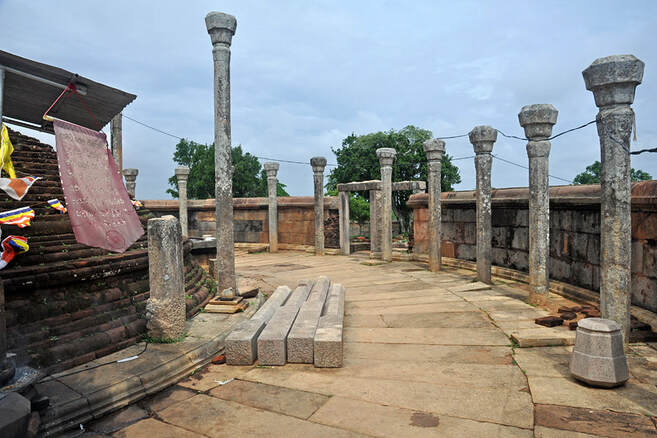 stupa inside the Vatadage of Thiriyai
stupa inside the Vatadage of Thiriyai
The Maluva platform within the Vatadage is 1.3 meters above the surrounding ground level of the hill’s summit plateau. The diameter of the circular temple is 24 m, that of the stupa in its center is 10 m.
Unlike most other round Chetiyagaras, the Vatadage of Thiriyai was encircled by only two rings of pillars supporting the roof. The inner ring around the stupa has 16 pillars, whereas the outer one near the wall has exactly twice this number.
These octagonal pillars are monoliths. This means, the chapiters are carved from the same stone as the shaft. In contrast, the temple pillars in Anuradhapura have separate capitals, with a hole and a pin on the top of the pillar‘s shaft for interlocking.
The roof of the Vatadage was probably made of wood, possibly it was also tiled. Presumably, the central part of the Vatadage, just above the stupa, was not roofed. although the exact form of such Chetiyagaras roofs is still under debate. In Thiriyai, whose two rows of columns are unusually wide apart, there may well have been third ring of pillar made of wood, from which, however, as with the roof, no remains have been found.
Unlike most other round Chetiyagaras, the Vatadage of Thiriyai was encircled by only two rings of pillars supporting the roof. The inner ring around the stupa has 16 pillars, whereas the outer one near the wall has exactly twice this number.
These octagonal pillars are monoliths. This means, the chapiters are carved from the same stone as the shaft. In contrast, the temple pillars in Anuradhapura have separate capitals, with a hole and a pin on the top of the pillar‘s shaft for interlocking.
The roof of the Vatadage was probably made of wood, possibly it was also tiled. Presumably, the central part of the Vatadage, just above the stupa, was not roofed. although the exact form of such Chetiyagaras roofs is still under debate. In Thiriyai, whose two rows of columns are unusually wide apart, there may well have been third ring of pillar made of wood, from which, however, as with the roof, no remains have been found.
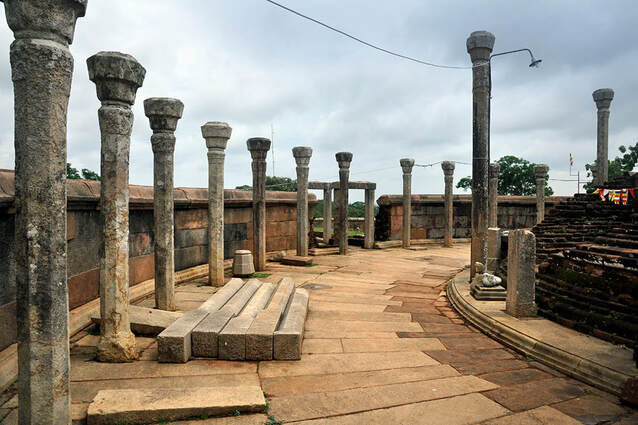 pillars in the interior of the Vatadage
pillars in the interior of the Vatadage
With regard to the construction concept, only two rings of stone column encircling the central stupa, the Vatadage of Thiriyai resembles most the slightly larger Ambasthala Dagoba of Mihintale. But the latter is not in ist original layout any more after modern restaurations and is without exterior ring wall.
Inscriptions by Thiriyai indicate that the stupa was built in the 8th century, which was a period of increasing influence of the South-Indian Pallavas on the art of the entire Indian Dekkhan and also on Sri Lanka. Furthermore, the Pallava influence in Thiriyai is epigraphically documented by an inscription from the reign of Manavanna (around 700), who with the help of Pallavas gained on the throne in Anuradhapura.
Excavation works under the present stupa found a smaller, older one below it, which is of course much older date than the Vatadage from the 8th century. Thiriyai has been a place of worship from the very early Buddhist period onwards, but the remaining structures are from the late Anuradhapura period.
Inscriptions by Thiriyai indicate that the stupa was built in the 8th century, which was a period of increasing influence of the South-Indian Pallavas on the art of the entire Indian Dekkhan and also on Sri Lanka. Furthermore, the Pallava influence in Thiriyai is epigraphically documented by an inscription from the reign of Manavanna (around 700), who with the help of Pallavas gained on the throne in Anuradhapura.
Excavation works under the present stupa found a smaller, older one below it, which is of course much older date than the Vatadage from the 8th century. Thiriyai has been a place of worship from the very early Buddhist period onwards, but the remaining structures are from the late Anuradhapura period.
Girikandi legend:
Tapussa and Bhallika and the Hair Relic of the Buddha
There is a famous legend concerning the origin of the oldest stupa of Thiriyai saying, that the very first Buddha relics are buried underneath it. The above-mentioned Sanskrit inscription further down the rock mentions the name Girikandi. This simply translates to rocky hill and may have been a very common name of elevated places in ancient times, not only of Thiriyai. However, that name may well refer to a familiar Buddhist story about a stupa called Girikanda-seya. The Dagoba of this name is believed to be the shelter of an original hair of the historical Buddha. Locals believe they were brought to Thiriyai by the very first Buddhist laymen, namely the merchants Tapussa and Bhallika.
